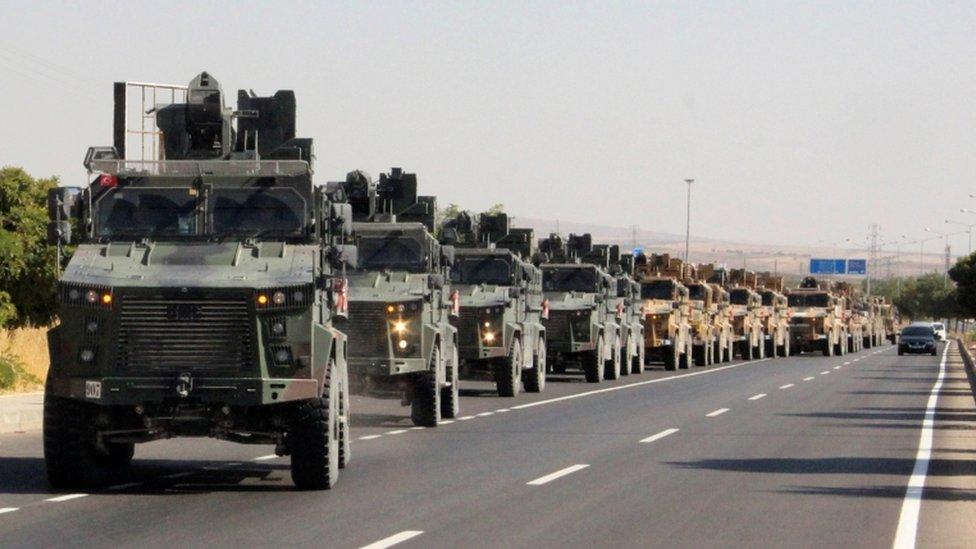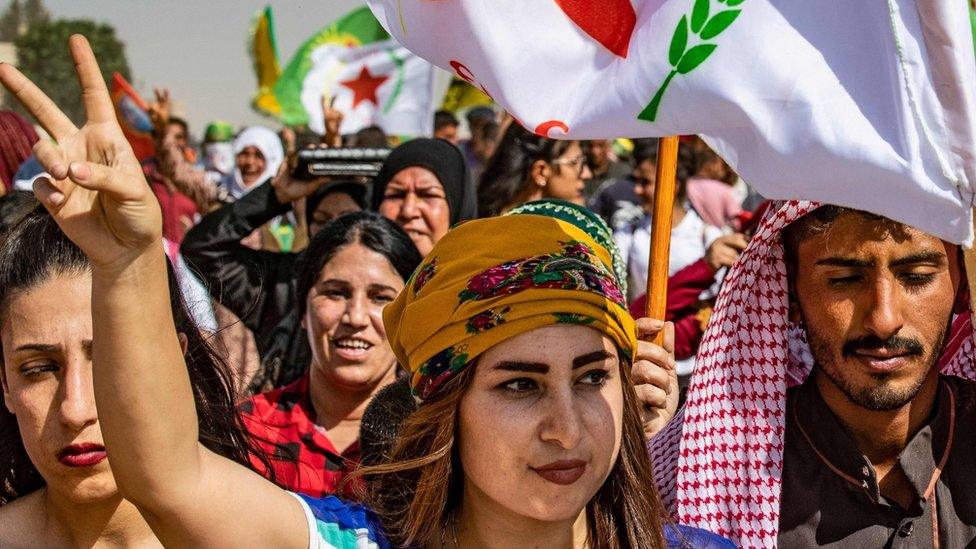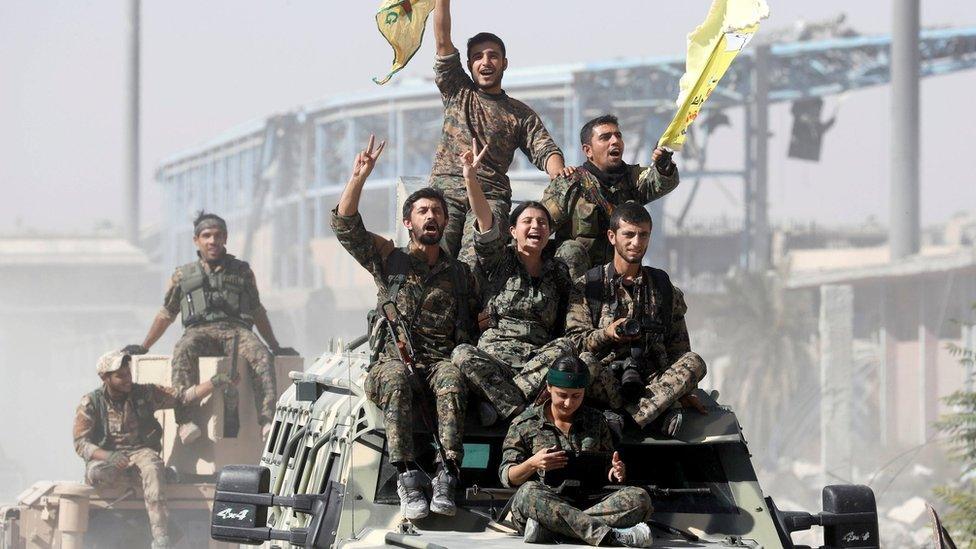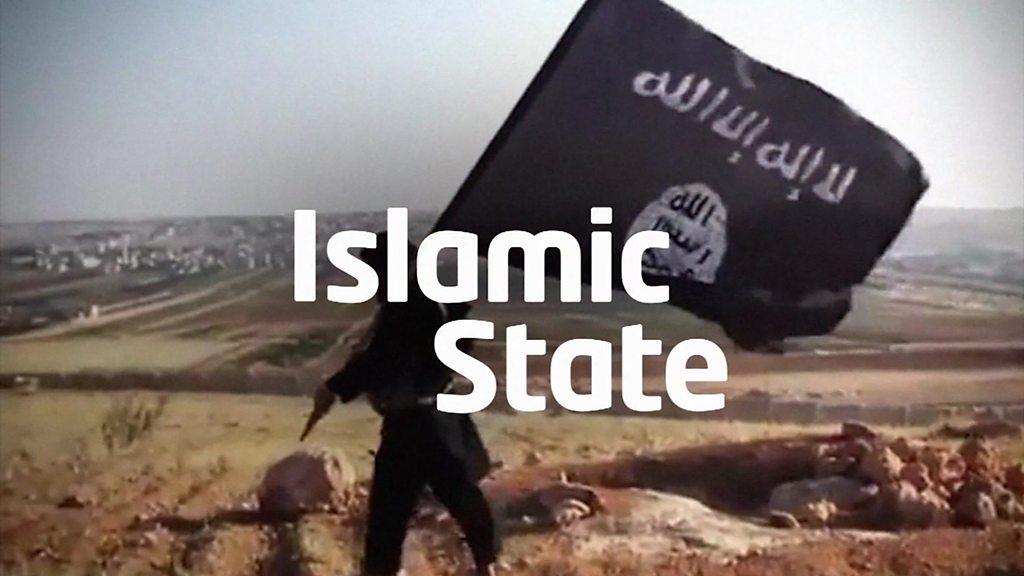Turkey Syria offensive: More than 100,000 people have fled their homes
- Published

Turkish troops prepare for the offensive in northern Syria
More than 100,000 people have fled their homes after Turkey launched a military offensive against Kurdish forces in northern Syria earlier this week.
Aid agencies are becoming increasingly worried and a refugee crisis is said to be developing.
"The situation on the ground is becoming increasingly dire, and once again, civilians are paying the highest price," said Misty Buswell, Middle East policy director at the International Rescue Committee. "There are already reports of [water] shortages in some rural areas, with possibly much worse to be seen in a few days if services are not able to get back up and running soon."
Aid groups say as many as 450,000 could be forced to move.
The UN Security Council (a group made up of the UK, France, Germany, Belgium and Poland) have called for Turkey to halt its military offensive.
UN Secretary General Antonio Guterres expressed his "deep concern" at the rising violence.
When did the military attack start?

Residents leaving their home town of Ras al-Ain
On Wednesday 9 October, Turkey launched a military offensive against Kurdish forces in northern Syria with airstrikes hitting towns on the border between the two countries.
This follows American President Donald Trump's decision to withdraw US troops from the area.
Many people have questioned his controversial decision and feel it has given Turkey the opportunity to launch this attack on Syria.
Why is there conflict between Turkey and the Kurds?

Syria's Kurds reject Turkey's plans and say they will defend their territory at all costs
There is a long-standing conflict between the Turkish state and the Kurds who live in Turkey, who constitute 15% to 20% of the population.
In response to uprisings in the 1920s and 1930s, many Kurds were resettled, Kurdish names and costumes were banned, the use of the Kurdish language was restricted, and even the existence of a Kurdish ethnic identity was denied, with people designated "Mountain Turks".
In 1978 a political organisation called the PKK was formed, also known as The Kurdistan Workers' Party. They called for an independent Kurdish state within Turkey.
Six years later, the group began an armed struggle for their independence. An estimated 40,000 people have been killed during the conflict and hundreds of thousands have been displaced.
Between 25 and 35 million Kurds live in a mountainous region around the borders of Turkey, Iraq, Syria, Iran and Armenia. They make up the fourth-largest ethnic group in the Middle East, but they have never had a permanent nation state - or country.
What does Turkey want to do in Syria?

Turkey's President Mr Erdogan wants to create what he has called a "safe zone" along Turkey's border with Syria. This "safe zone" is 480km (300 mile) long and 30km deep.
Their plan is to resettle up to two million of the more than 3.6 million Syrian refugees currently living in Turkey in the area.
Turkey's defence ministry said that creating such a zone was "essential" for Syrians and for peace in the region.
But Turkey has also repeatedly threatened to attack Kurdish fighters across the border in north-eastern Syria, who they view as terrorists.
Who are the SDF?

The Syrian Democratic Forces alliance led the fight against the Islamic State group in Syria
Founded in 2015, the SDF (Syrian Democratic Forces) says it wants to be given an area in northern Syria which is independently governed by them.
The group is largely made up of Kurdish fighters called YPG and smaller groupings of Arab, Turkmen and Armenian forces.
The People's Protection Units (YPG) is the dominant military force in the SDF.
Turkey considers the YPG an extension of the banned Kurdistan Workers' Party (PKK) which has fought for Kurdish independence in Turkey for decades.
The YPG and PKK share a similar set of beliefs, but they say they are separate groups.
Until now, the US had supported the SDF, as they worked together to defeat Islamic State in Syria. IS is a militant group with extreme, violent views, which has used this violence against anyone who doesn't agree with what they think.
The SDF is not happy with America's decision to remove its forces from the border between north-eastern Syria and Turkey.
The Kurdish-led group says it will defend its territory and that the US is "leaving the area to turn into a war zone" and risking the revival of the Islamic State group.
- Published16 October 2019

- Published18 August 2017

- Published23 August 2013
